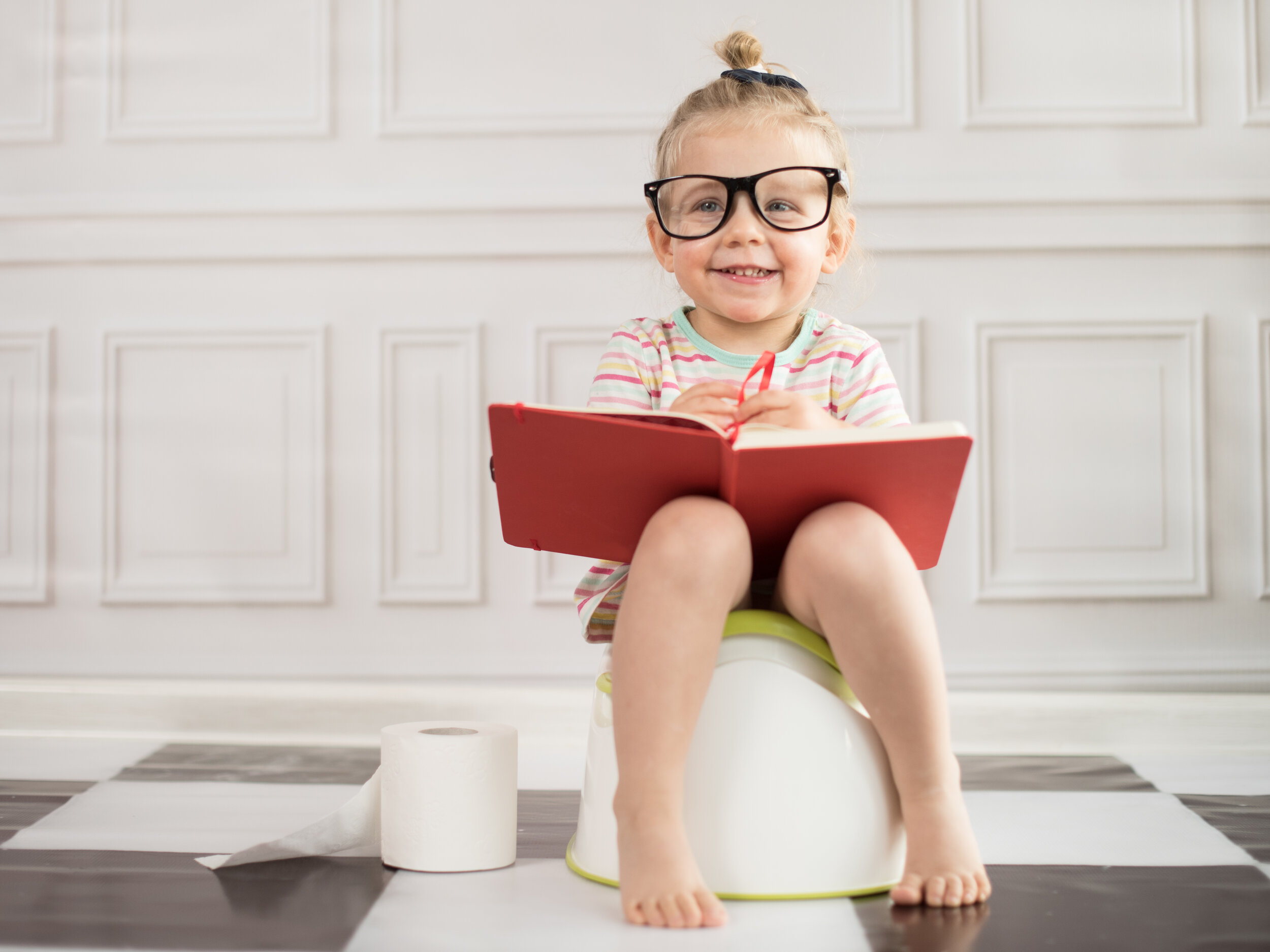Potty Training Thoughts and Favorite Products
/Few things can spark fear in a toddler mom’s eyes like the words “potty training.” It feels like such a huge thing – and unlike sleep training (if you chose to do that), potty training also means dealing with a toddler’s emotions, strong wills and stubbornness. Also unlike sleep training, it can be very messy until you get to the end state.
With my oldest, I decided that we would do the boot camp method to get her using the potty early and quickly. I had been hearing about a friend’s six-month struggle to get her daughter fully trained and pooping on the potty, and I thought, nope that sounds harder and I’d rather just get it over with. So we read the book Oh Crap and set a date over a long weekend shortly after my daughter turned 2. I then scrambled to get rid of the cute potty I’d bought with a handle and realistic flush noise (read: toy) and Amazon Primed a no-frills potty that was purely about business (pun intended). I rolled up the rugs, lay pee pads all over the couch, sectioned off strategic areas of our apartment with baby gates, and we were off to the races.
I found the process very stressful, hovering over my daughter during the entire day and watching with hawk eyes for the most subtle sign that she had to pee or poop, then trying to catch it before she went on the floor, and then cleaning up the inevitable “accident.” A month later, however, I was glad we did it that way because it was done. A few thoughts and tips if you do decide on this method:
Allot longer than 3 days if you can. I’m guessing very few kids are actually potty trained in 3 days, as these type of potty training boot camp methods promote. You can definitely make headway during that time, but I would say it probably takes most kids a solid 7 days to really get the hang of it. We had only allotted a long weekend and our daughter had to go back to daycare on Day 4, where they required her to wear pull-ups until she had been dry for 2 weeks. I was annoyed and stressed all week that it was all for nothing and she was completely regressing to Day 0 – but we kept it up in the morning and at night at home, and the second weekend at home it really clicked for her.
If Day 2 seems to get worse than Day 1, do not give up because this is normal. It’s like a lot of things with kids – when the novelty wears off, they’re like, nah I’m not going to do this anymore. And many toddlers can be stubborn AF. If you stick with it and keep consistent in your approach, Day 3 is likely to be better. If it’s not and this feels exponentially hard, there’s no shame in saying let’s save our sanity and try this again later.
Don’t plan anything for the long weekend or week that you decide to potty train. You don’t want to be locked into plans on Day 3 when your kid is definitely not ready to put pants on yet. Even if an outing somehow doesn’t set you back, it will be too stressful to be out and about with a kid who might poop in their pants at any moment.
Have a lot of activities ready to go that you can do in your house or apartment. Three days stuck at home with a toddler is loooonnnng and can be crazy making. I had my daughter do a lot of painting with a new easel I’d gotten for her second birthday, which I highly recommend because pantless painting is pretty cute.
Take the book with a grain of salt. I did not leave our daycare because they required pull-ups until they showed clear signs of being potty trained. I did put my daughter in pull-ups for a while after potty training when we were going to be in the car, because I did not want to clean that out of the car seat and thought it was the far lesser evil to pulling over on the side of the highway to have her pee next to traffic moving at 80mph, as the author suggests. I did not night train until I thought she was ready (which didn’t end up being until she was close to 4.5), because I did not want to disrupt either of our sleep by waking her up in the night to pee, and I’m not afraid that she’ll have lifelong bladder issues as a result. And if you’re just starting to think about this at age 3, you most likely did not miss the crucial window of 20-30 months after which it will be nearly impossible (it will not) and they will have ongoing incontinence from a bladder that wasn’t trained on time (they will not).
If you decide to potty train in the more traditional method, where you have a potty available and put your kid in pull-ups and gently encourage them to try the potty if they feel the urge – that is cool too. I can’t speak to that because I haven’t done it yet, but I very well might with my son because we’re living in a rental house with wall-to-wall shag carpets that I can’t roll up, and I also can’t keep us locked in the house for an entire weekend when we have an older kid to entertain. Many people prefer this method of not actively potty training, because it feels more approachable, less stressful, and potentially much easier if you follow the lead of a child who is truly ready to start using the potty. It often happens at a slightly later age when they can communicate better and when daycare/preschool will support the process in the classroom, which can be helpful too. When we potty trained our daughter, she was the first in her class and it was nearly a year before she would be transitioned to the classroom in which they’d support potty training. This definitely made it harder since we were trying to create routines that didn’t exist and she didn’t have any of that helpful peer pressure that can get a kid in a social environment to do new things (e.g., eat their peas when everyone else is eating them too).
Whatever you decide, try not to stress TOO much, because everyone uses the toilet eventually, and every kid has accidents, and it’s all normal and not a race or competition. Here are some of the products I found helpful when we started potty training.
Favorite Potty Products
Potty Training Books
See Favorite Books for Babies & Toddler, “Potty Training Books” section
Potty
BABYBJORN Smart Potty – This one was great to start with, because it’s just the right size for a toddler, allowing them to be positioned correctly for pooping and to self-initiate when they need to go. I was apprehensive about how gross it would be to clean out a stand-alone potty, but it wasn’t as bad as I thought – mostly, you’re just so excited that your kid pooped in the potty that you’re happy to clean it out.
Potty Training Seat with Step Stool Ladder – If you really want to skip the small stand-alone potty, this is a great option. It’s very sturdy and the large step and handles make it easy for a child to climb up and sit on the toilet themselves.
Potty Training Seat With Cushion Handle And Backrest (+ Hook to hang it when not in use) – If you live in a small apartment and don’t have space for the potty training seat with step stool ladder, this seat rests on the toilet and you can hang it on the side of your toilet with a hook when your child is not using it. You’ll also need a step stool for them to climb up to use the toilet, but you’ll need this anyway for hand washing and teeth brushing, so you’re not adding another thing to a tight space.
On-The-Go
OXO Tot 2-in-1 Go Potty for Travel (+ Refill Bags) – I scoffed at the idea of carrying around a potty everywhere I went before I had a child of potty training age, and then I quickly saw the brilliance and necessity in it. There is not always a public bathroom available on short notice, and even if there is one, there may be lines or it may not be one you’re comfortable using since your child will inevitably touch something gross as hard as you try to avoid that. This little portable potty easily fits in a diaper bag, backpack, or stroller basket. We even still throw it in the trunk of our car for our 4.5-year-old if we’re going somewhere we’re not sure there will be a public bathroom available.
Gimars Folding Portable Reusable Toilet Potty Training Seat Cover – If you know that there will be a bathroom available where you’re going, this foldable seat that rests on top of a toilet is also great to have, because it makes the seat size much more approachable for toddlers. Some young kids are scared of using a big toilet, and even if they’re not, it can be hard to prop them on it while wiping, plus this seat acts as a barrier between their skin and a potentially gross toilet seat. It folds up super small so it’s easy to throw in any bag.
Disposable XL Toilet Seat Covers – For the times you’re using the Gimars folding seat, these disposable seat covers and great to have because you can put one on the toilet seat with the Gimars seat on top so that it doesn’t get dirty. And when your child is ready to use the toilet without a potty seat, it provides much better coverage than traditional seat covers.
Step Stool
2 Step Stool for Kids (2 Pack), Slip Resistant Soft Grip – These are great step stools for whatever you may need them for – getting up to a toilet, washing hands, brushing teeth, helping in the kitchen. A lot of step stools can be a little slippery, but these have a great nonslip grip on both the step and the top.
Faucet Extender
This is an ingenious invention to help a young child wash their hands because it pushes the water stream out farther. Since about 18 months, my son has been able to stand on the step stool listed above to wash his hands, which is much easier than holding him up over the sink. He loves the autonomy too. There are a few different kids, so you should try to figure out which would work better on your sinks depending on the shape of the faucet – my two favorites are the Munchkin Faucet Extender and the Prince Lionheart Faucet Extender.

